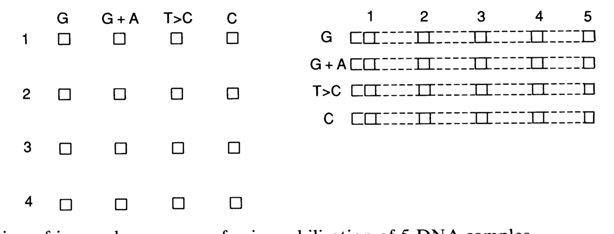![]() Go to frame view (Recommended only for
screen resolution 1024x768)
Go to frame view (Recommended only for
screen resolution 1024x768)
6.8 Solid-Phase Sequencing of DNA and RNA
Oligo- and polynucleotides can be sequenced by the Maxam-Gilbert method with a much lower expenditure of time and reagents if the DNAs and RNAs of interest are first immobilized on modified filter paper.
The solid-phase sequencing principle can best be illustrated by determination of the primary structure of DNA fragments. Used for immobilization is Whatman 540 paper activated with cyanuric chloride and then converted with 2-bromoethylamine in the presence of triethylamine.
The immobilization of DNA on paper prepared in the above manner is achieved through ion exchange. 120 mg of DNA can be immobilized per square centimeter of paper. Depending on the number of DNA samples to be sequenced, 4n pieces of paper (2-4 mm2, see Fig. 6-32, left) are cut and marked with a pencil. Paper strips can also be used (Fig. 6-32, right). The DNA to be analyzed (0.5-1.0
ml of sample labeled at the 5' or 3' end) is applied onto the prepared paper. When paper strips are used, the DNA application points must be spaced 2 to 5 mm apart. The paper (all pieces or strips) is placed in four reaction vessels to conduct the reactions (G, G+A, T, C).
Fig. 6-32. Preparation of ion-exchange paper for immobilization of 5 DNA samples.
The base modification conditions have been changed slightly in comparison with the standard reactions normally used for sequencing in solution. Direct use of the latter for solid-phase sequencing has turned out to be impossible because of the sizable DNA losses during the modifications (hydrazinolysis, alkaline treatment). Dimethyl sulfate is used to modify DNA at the guanines; the position of adenine and guanines (A+G) is determined by treating the samples with 66-88% formic acid or diethyl pyrocarbonate at 900 C (A>G). The following scheme illustrates the transformations undergone by adenine in the presence of diethyl pyrocarbonate with subsequent opening of the imidazole ring. The first step is acylation of the nitrogen (N7) in imidazole.
Subsequently, the hydroxyl anion (strong nucleophile) immediately attacks the carbon at position 8 of the imidazole ring, which leads to cleavage of the C8-C9 bond:
To modify cytosines in DNA hydroxylamine is used (pH 6) instead of hydrazine. It is believed that hydroxylamine is added at the double C5-C6 bond and the amine group is substituted. The base modified in this manner is detached in the presence of piperidine from the polynucleotide chain which is then cleaved as usual.
To determine the position of thymines (T) during solid-phase sequencing use is made of oxidation with potassium permanganate in aqueous solutions. The intermediate products of this reaction are 5,6-dihydroxy-5,6-dihydro derivatives.
These compounds undergo fast opening of the pyrimidine ring at the C5-C6 bond, and the sequence of transformations results in formation of N-substituted ureas NH2-CO-NH-R (where R is a polynucleotide). Similar transformations are undergone by cytosines. The oxidation rate of thymines is much higher than that of cytosines. Therefore, the reaction with permanganate makes it possible to determine the position of the former in the first place.
Treatment with piperidine (conditions under which b-elimination takes place) is performed separately for each DNA sample (if paper strips are used, they must be cut). The paper is treated with 10 % aqueous piperidine (30 min, 900 C), which leads to elution of the DNA. The subsequent treatment, PAGE and autoradiography are carried out under standard conditions.
It should be noted that the solid-phase method allows one to analyze a large number of DNA samples at a time, which cuts down the sequencing time considerably.
For solid-phase RNA sequencing ion-exchange Whatman DE 81 paper is used. 3'-Labeled RNA is immobilized on 4n 2-4 MM2 pieces of paper, depending on the number of samples, which are then marked with a pencil and placed in four vessels to perform the corresponding modifications. The following conditions are maintained to determine the position of bases in the RNA chain:
<>G: dimethyl sulfate (pH 5.5, 900, 1 min) with subsequent NaBH4 treatment (pH 7, 00, 30 min)
A>G: diethyl pyrocarbonate (pH 4.5, 900, 10 min)
U+C: 50 % aqueous hydrazine (00, 20 min)
C: 3 M NACI in anhydrous hydrazine (00, 10 min).
After modification all paper segments are treated together with 1 M aniline-acetate buffer (pH 4.5, 600 C, 20 min). For desorption of RNA each paper segment is treated with 2 M NaCIO4. RNA is precipitated with an alcohol and subjected to PAGE. The entire procedure takes two hours - that is, the analysis in this case is much quicker than RNA sequencing in solution. Time saving is the greatest when a large number of RNA samples are analyzed, and solid-phase sequencing allows many RNA fragments to be processed simultaneously.